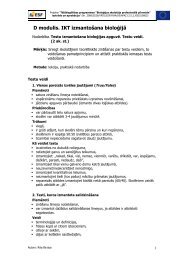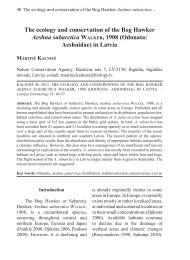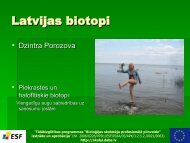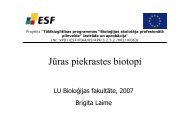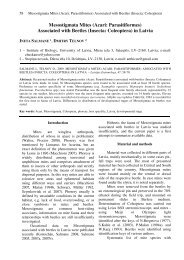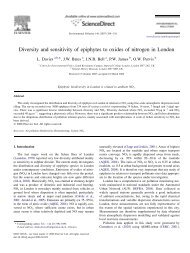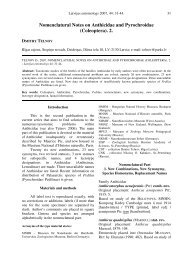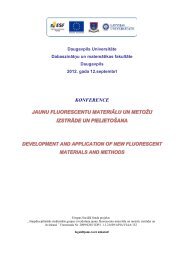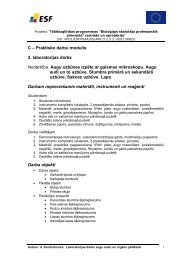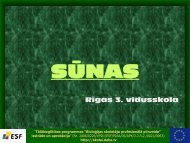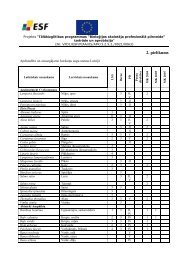Odonata - Entomological Society of Latvia - Latvijas Daba
Odonata - Entomological Society of Latvia - Latvijas Daba
Odonata - Entomological Society of Latvia - Latvijas Daba
Create successful ePaper yourself
Turn your PDF publications into a flip-book with our unique Google optimized e-Paper software.
many other issues are not specific to <strong>Latvia</strong> only, but also to other countries like Poland (Bernard et<br />
al. 2009).<br />
Figure 17. The squares <strong>of</strong> <strong>Latvia</strong> according to the number <strong>of</strong> the species identified in one square and<br />
the network <strong>of</strong> specially protected nature areas (NATURA 2000).<br />
According to the relative distribution <strong>of</strong> the species, in <strong>Latvia</strong> there are mostly moderately<br />
represented species (S=19). Very common, common, localized and very rare distributed species are<br />
less common (S=9-12). Most dragonfly species can be encountered throughout the territory <strong>of</strong><br />
<strong>Latvia</strong> due to the various habitats that are represented. For example, there are ~600 m/km 2 <strong>of</strong><br />
flowing water in <strong>Latvia</strong> (Pastors 1995; Eipurs, Zīverts 1998) or 15 km in one the 5x5 km square.<br />
This provides habitat for moderate or vast distribution <strong>of</strong> almost any flowing water species, for<br />
example, Calopteryx splendens, Gomphus vulgatissimus etc. However, for some species, for<br />
instance, Ophiogomphus cecilia, Cordulegaster boltonii and Gomphus flavipes, regional differences<br />
<strong>of</strong> distribution were observed. The rare occurrence <strong>of</strong> Gomphus flavipes is mainly related to the<br />
habitat specific to the species – large rivers that are not well represented in <strong>Latvia</strong>. Accordingly, this<br />
species is mainly found near the Daugava River. The non-homogenous distribution <strong>of</strong><br />
Cordulegaster boltonii is most likely related to the secretive lifestyle <strong>of</strong> the species and the specific<br />
habitat – shady streams and small rivers. This species is mainly identified in locations where the<br />
extended research takes place.<br />
Also standing waters are greatly represented in the whole territory <strong>of</strong> <strong>Latvia</strong>; in some river<br />
basins the lake coverage reaches even 10 % (Pastors, 1995). Additional possibilities for distribution<br />
are provided by the growing number (especially in the last 10-15 years) <strong>of</strong> household ponds<br />
(unpublished data by the State Environmental Service). Thus, there are very vast distribution<br />
possibilities for ecologically more plastic species like Libellula quadrimaculata, Aeshna grandis,<br />
Aeshna cyanea, Coenagrion puella. Regional differences were observed for species with specific<br />
habitat needs (Aeshna subarctica – raised bogs with water pools), species that are in the periphery<br />
<strong>of</strong> their areas (Coenagrion johanssoni – <strong>Latvia</strong> lies in the south-western side <strong>of</strong> the area), as well as<br />
species the distribution areas <strong>of</strong> which are affected by climate change (see previously Changes <strong>of</strong><br />
fauna).<br />
The occurrence <strong>of</strong> the species is not related to the size <strong>of</strong> the species, as all categories <strong>of</strong><br />
relative distribution include both large and small species. From sporadically distributed species only<br />
one – Ischnura pumilio – is small in size (perhaps, more difficult to notice). Only 20 species have<br />
69



